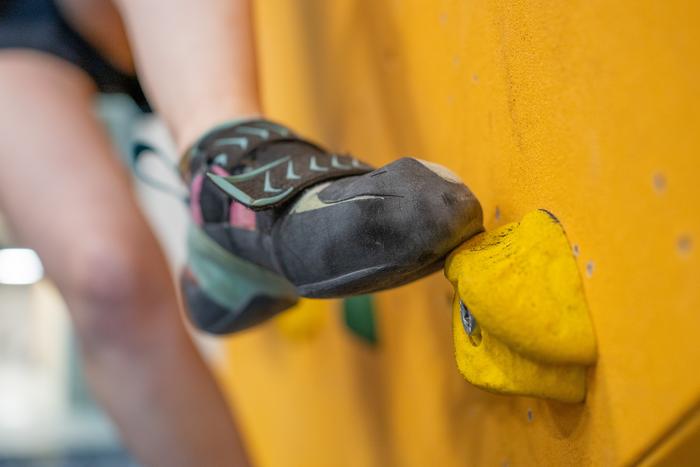Indoor climbing is often heralded as both a physically demanding sport and a recreational pursuit, where athletes challenge themselves while staying healthy in a controlled environment. However, a growing body of research indicates that the climbing shoes, vital for performance, may harbor hidden dangers that could compromise the very health climbers seek to enhance. A study conducted by researchers from the University of Vienna and EPFL Lausanne has revealed concerning findings about the chemicals in these shoes and their impacts on air quality in climbing gyms, drawing parallels to the pollution levels found in busy urban streets.
The vibrant colors of climbing holds may attract climbers, yet they also serve as a shocking reminder of a less visible concern: the wear and tear of rubber soles from climbing shoes. Over time, these soles shed microscopic particles that can contaminate the surrounding air. Previous studies have shown that indoor environments can harbor pollutants, and this comprehensive research has taken a bold step in identifying that some of these contaminants may originate directly from climbing equipment itself.
At the heart of this investigation was a detailed analysis led by environmental scientist Thilo Hofmann at the University of Vienna. His research team utilized sophisticated particle-measuring devices known as impingers, which simulate the human respiratory tract, to collect air samples from various bouldering gyms. This method allowed the researchers to accurately assess the concentration of airborne pollutants, particularly those arising from the abrasion of climbing shoe soles.
The implications of these findings are alarming. The study uncovered that the levels of rubber additives in the air of bouldering gyms exceeded the concentrations typically found in some of the world’s busiest thoroughfares. Such a stark juxtaposition raises significant concerns about the health risks posed to indoor climbers, whose exposure to these harmful compounds may be substantial, particularly in enclosed spaces where many athletes congregate.
The connection between the climbing shoes and air quality is not just speculative; the researchers identified specific rubber additives common in both climbing shoes and car tires. Among these substances, 6PPD, a stabilizer notorious for its environmental consequences, is particularly concerning due to its association with ecological damage, notably concerning salmon populations in aquatic ecosystems.
As the research unfolds, the long-term health effects on climbers exposed to these airborne chemicals remain uncertain, yet the evidence suggests an urgent need for action. Hofmann emphasizes the need for proactive measures in climbing environments, especially to safeguard vulnerable groups, such as children and novice climbers who may be more susceptible to adverse health outcomes.
The climbing industry has historically focused on performance and durability in shoe design, prioritizing high-functioning materials but often at the expense of chemical safety. Environmental scientist Anya Sherman, a vocal advocate for better practices, notes that the climbing community’s awareness of these chemical issues is still alarmingly low. Manufacturers often use rubber sourced from suppliers who combine various chemicals without full knowledge of their potential hazards.
The study received enthusiastic support from climbing gym operators, who expressed a keen interest in improving air quality within their facilities. Sherman highlights that constructive dialogue between researchers and gym owners can pave the way for practical solutions. Implementing better ventilation systems, rigorous cleaning protocols, and rethinking shoe materials could significantly mitigate the risks associated with rubber contaminants in the air.
In a forward-looking analysis of the climbing landscape, Hofmann calls for stricter regulations and higher safety standards in climbing shoe production. Making strides toward more environmentally friendly materials will not only enhance climbers’ health but can also inspire a cultural shift within the industry. Moreover, increasing research into the effects of these chemicals on human health may enlighten manufacturers and consumers alike about the necessity for change.
Sherman’s passion for climbing motivates her and her colleagues to persist in their research endeavors, confident that the outcomes will enhance standards in climbing gyms and improve the overall climbers’ experience. As the scientific community continues to marshal its resources to investigate the interplay between recreational sports and environmental health, it remains clear that awareness and action are needed to ensure that climbing remains not only an exhilarating pursuit but a healthy one as well.
In light of these revelations, the conversation about health and safety in climbing is poised to evolve. As the climbing community grapples with the implications of this research, climbers and stakeholders alike will be forced to reconsider the products they use and the environments they frequent. Ultimately, the goal remains the same: to conquer new heights while prioritizing health and safety in every ascent.
Beyond the immediate concerns of climbers, this investigation has wider implications for industrial practices related to rubber products. The findings inspire a call to action for manufacturers across the board to prioritize both performance and the environmental and health impacts of their products. As climbers prepare for their next ascent, it is crucial for them to be informed and aware of the invisible footprints they leave behind—and breathe in—within climbing gyms.
As this conversation continues to unfold, the researchers hope their study serves as a catalyst for essential changes in both policy and practice, ensuring that the climbing community can thrive in environments that foster health, safety, and enjoyment.
Subject of Research: Health implications of rubber additives from climbing shoes in indoor environments
Article Title: The Invisible Footprint of Climbing Shoes: High Exposure to Rubber Additives in Indoor Facilities
News Publication Date: 24-Apr-2025
Web References: DOI Link
References: ACS ES&T Air
Image Credits: Aaron Kintzi/CeMESS
Keywords
Indoor climbing, rubber additives, air quality, environmental health, climbing shoes, pollutant exposure, climbing gyms, air pollution, chemical safety, sustainable practices.
Tags: chemical pollutants in climbing shoesclimbing gear chemical analysisclimbing holds color safety concernsclimbing shoe wear effectsenvironmental impact of climbing equipmenthealth risks of climbing shoesindoor climbing gym air qualityindoor sports environments contaminationresearch on climbing shoe materialsrubber sole particulate matterThilo Hofmann environmental studyurban pollution comparison in gyms





